Variations in Atmospheric CO2 Mixing Ratios across a Boston, MA Urban to Rural Gradient
Abstract
:1. Introduction
2. Results and Discussion

2.1. Trends in Observed CO2

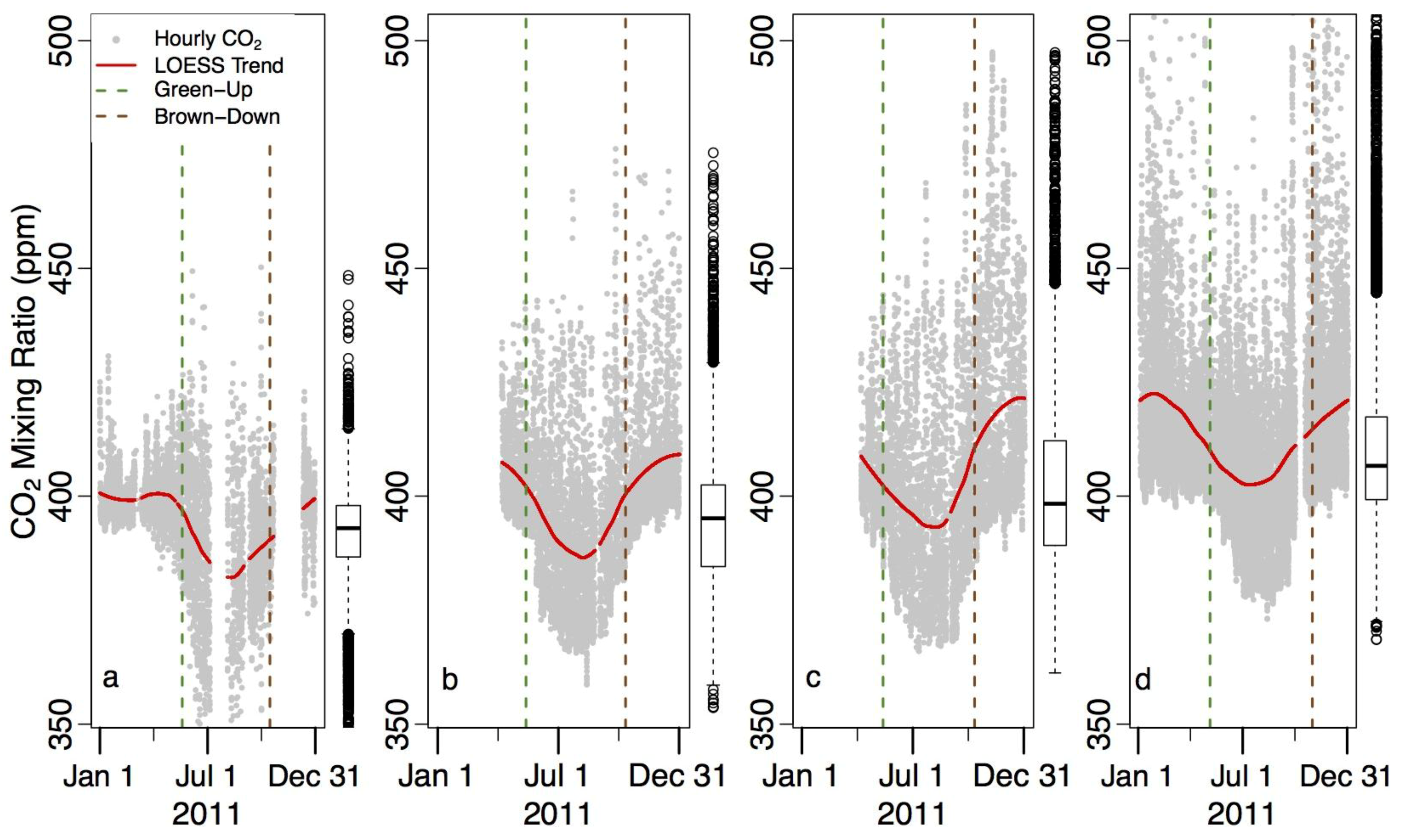
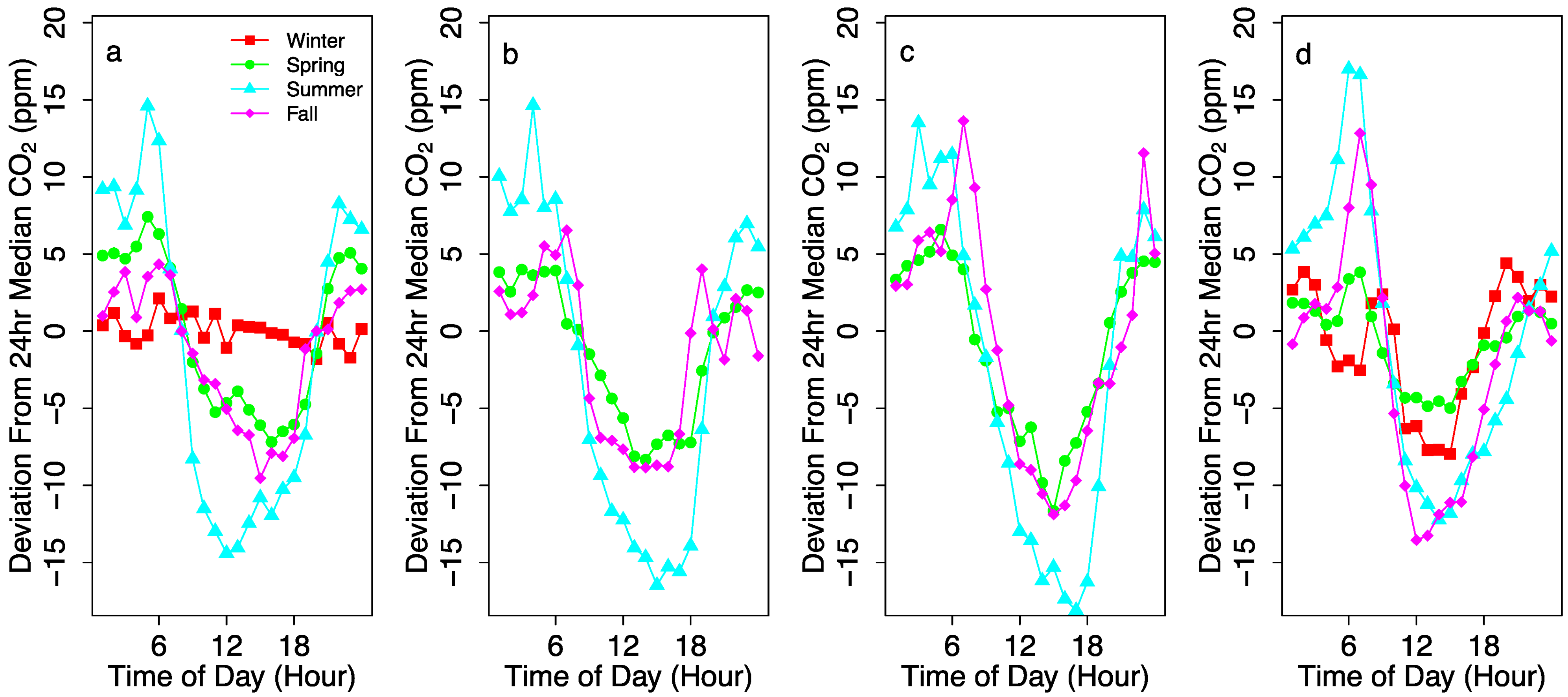
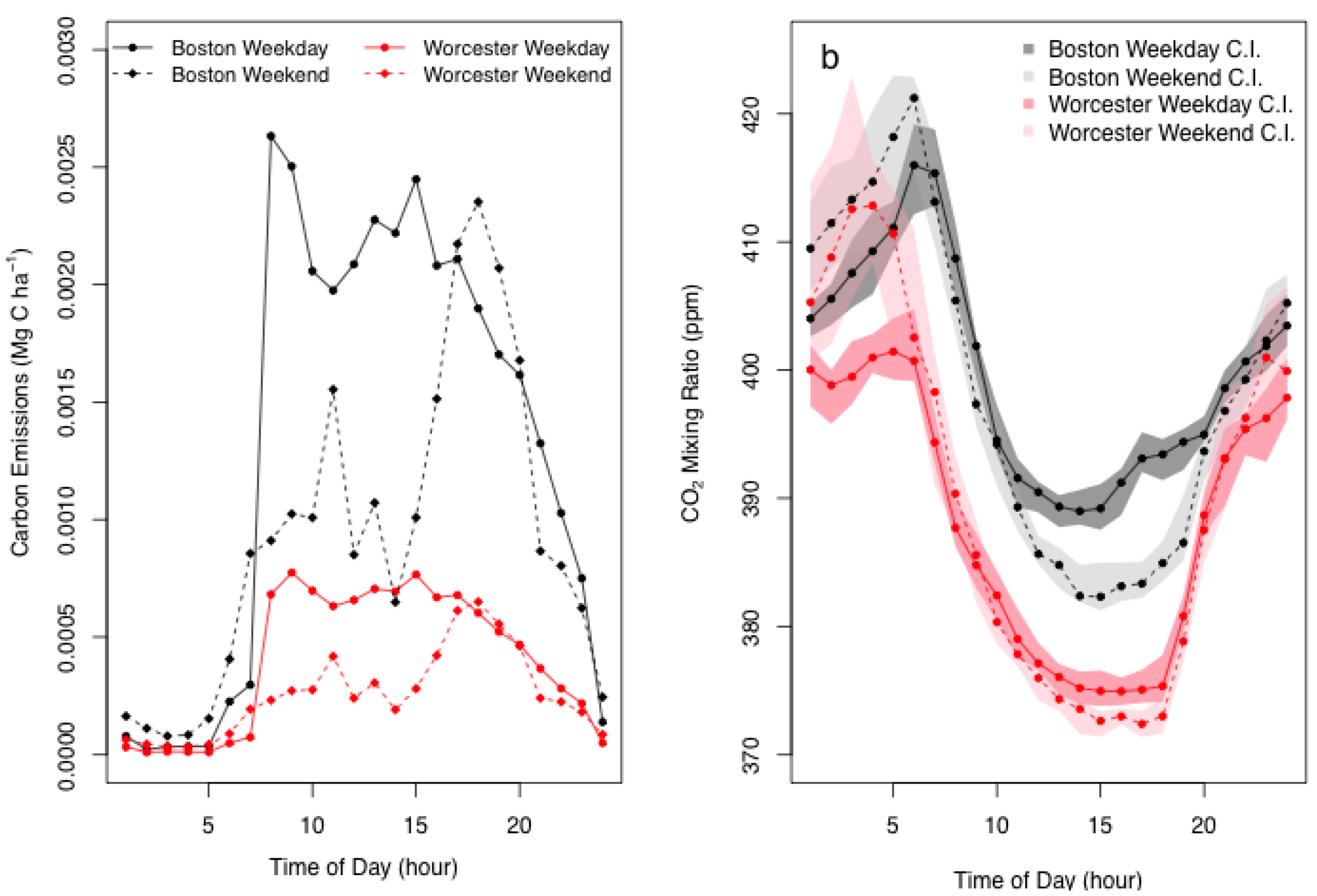
2.2. Enhanced Vegetation Index (EVI) Time Series and Phenology Timing
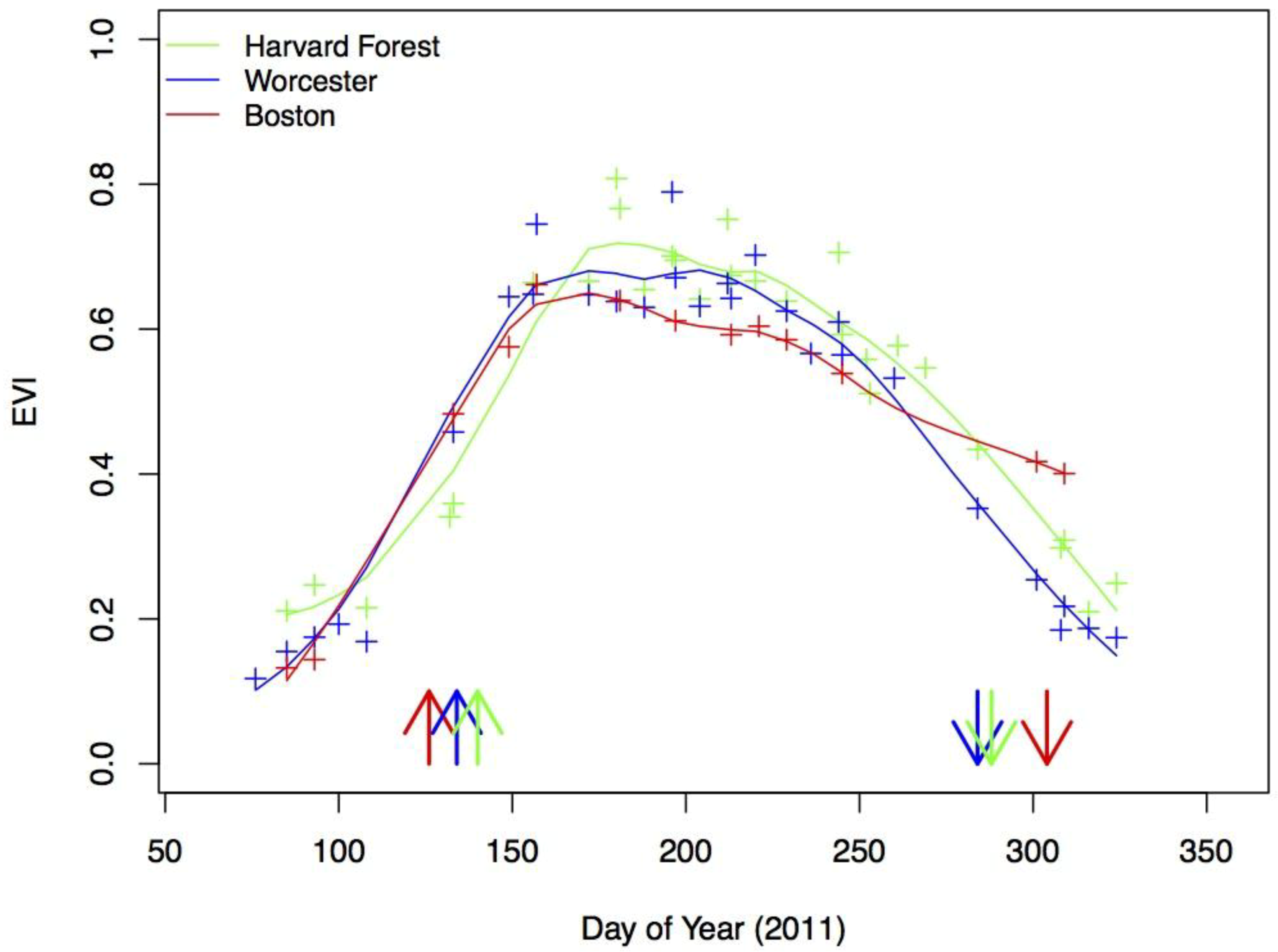
2.3. Land Cover and Relationship to CO2

3. Experimental Section
3.1. Site Description
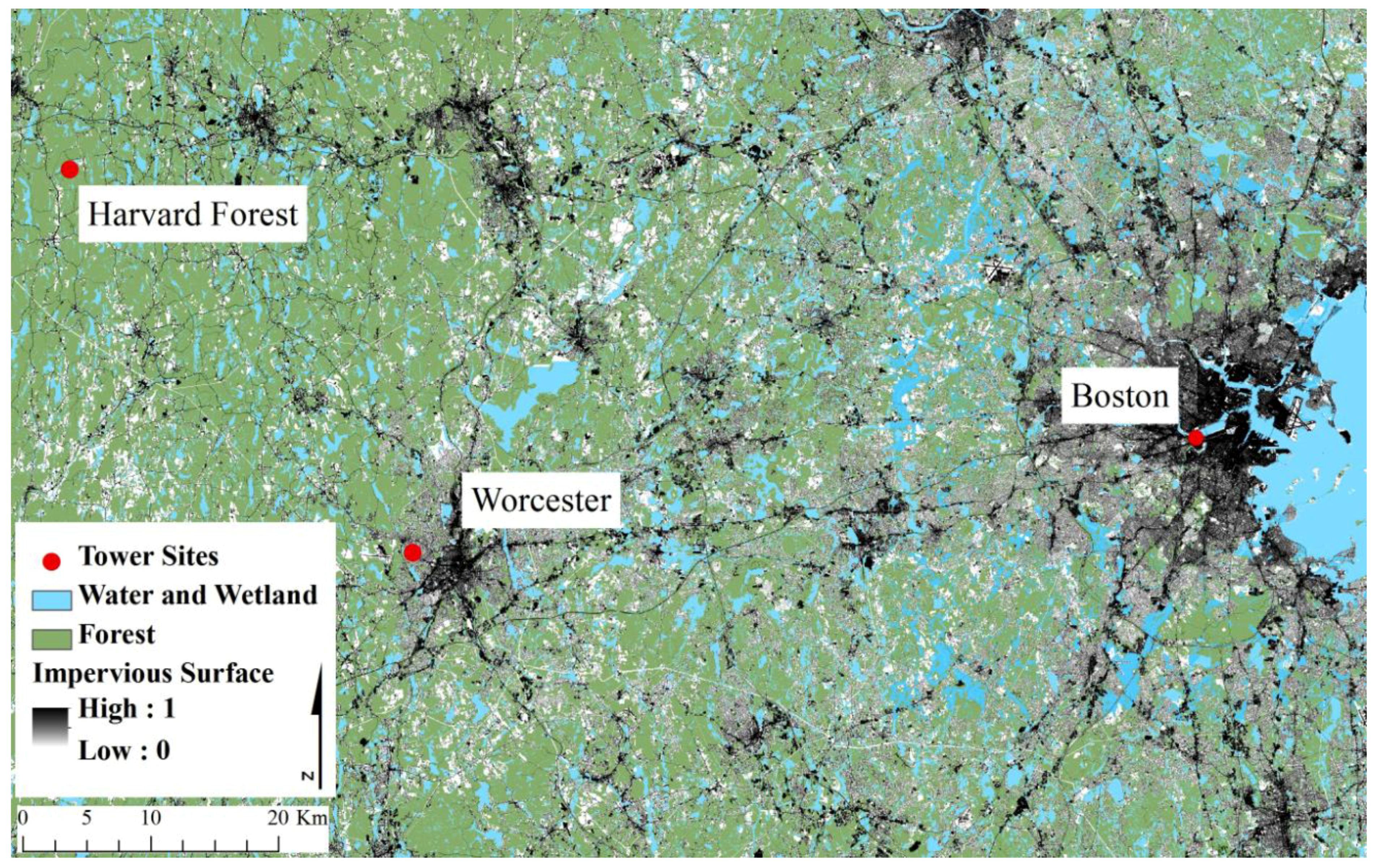
3.2. Instrumentation and Data Analysis
3.3. Anthropogenic and Biogenic Carbon Fluxes
3.4. Phenology Timing and Time Series
3.5. Spatial Analysis
4. Conclusions
Acknowledgments
Conflict of Interest
References and Notes
- The United Nations Department of Economic and Social Affairs. World Urbanization Prospects, the 2011 Revision. Available online: http://esa.un.org/unup/ (accessed on 10 January 2013).
- Schneider, A.; Friedl, M.A.; Potere, D. A new map of global urban extent from MODIS satellite data. Environ. Res. Lett. 2009, 4, 168–182. [Google Scholar]
- Seto, K.C.; Reenberg, A.; Boone, C.G.; Fragkias, M.; Haase, D.; Langanke, T.; Marcotullio, P.; Munroe, D.K.; Olah, B.; Simon, D. Urban land teleconnections and sustainability. Proc. Natl. Acad. Sci. USA 2012, 109, 7687–7692. [Google Scholar] [CrossRef]
- DeFries, R.S.; Rudel, T.; Uriarte, M.; Hansen, M. Deforestation driven by urban population growth and agricultural trade in the twenty-first century. Nat. Geosci. 2010, 3, 178–181. [Google Scholar] [CrossRef]
- World Energy Outlook: 2008; International Energy Agency: Paris, France, 2008.
- Velasco, E.; Roth, M. Cities as net sources of CO2: Review of atmospheric CO2 exchange in urban environments measured by eddy covariance technique. Geogr. Compass 2010, 4, 1238–1259. [Google Scholar] [CrossRef]
- Grimmond, C.S.B.; King, T.S.; Cropley, F.D.; Nowak, D.J.; Souch, C. Local-scale fluxes of carbon dioxide in urban environments: Methodological challenges and results from Chicago. Environ. Pollut. 2002, 116, S243–S254. [Google Scholar] [CrossRef]
- Baldocchi, D. Breathing of the terrestrial biosphere: Lessons learned from a global network of carbon dioxide flux measurement systems. Aust. J. Bot. 2008, 56, 1–26. [Google Scholar] [CrossRef]
- Oke, T.R. Boundary Layer Climates, 2nd ed; Methuen: London, UK/New York, NY, USA, 1987; Volume XXIV, p. 435. [Google Scholar]
- Oke, T.R. The energetic basis of the urban heat-island. Quart. J. Roy. Meteorol. Soc. 1982, 108, 1–24. [Google Scholar]
- Zhang, X.Y.; Friedl, M.A.; Schaaf, C.B.; Strahler, A.H. Climate controls on vegetation phenological patterns in northern mid- and high latitudes inferred from MODIS data. Glob. Change Biol. 2004, 10, 1133–1145. [Google Scholar] [CrossRef]
- Richardson, A.D.; Black, T.A.; Ciais, P.; Delbart, N.; Friedl, M.A.; Gobron, N.; Hollinger, D.Y.; Kutsch, W.L.; Longdoz, B.; Luyssaert, S.; et al. Influence of spring and autumn phenological transitions on forest ecosystem productivity. Phil. Trans. Roy. Soc. B-Biol. Sci. 2010, 365, 3227–3246. [Google Scholar] [CrossRef] [Green Version]
- Pickett, S.T.A.; Cadenasso, M.L.; Grove, J.M.; Boone, C.G.; Groffman, P.M.; Irwin, E.; Kaushal, S.S.; Marshall, V.; McGrath, B.P.; Nilon, C.H.; et al. Urban ecological systems: Scientific foundations and a decade of progress. J. Environ. Manage. 2011, 92, 331–362. [Google Scholar] [CrossRef]
- McDonnell, M.J.; Hahs, A.K. The use of gradient analysis studies in advancing our understanding of the ecology of urbanizing landscapes: current status and future directions. Landscape Ecol. 2008, 23, 1143–1155. [Google Scholar] [CrossRef]
- Idso, C.D.; Idso, S.B.; Balling, R.C. An intensive two-week study of an urban CO2 dome in Phoenix, Arizona, USA. Atmos. Environ. 2001, 35, 995–1000. [Google Scholar] [CrossRef]
- Strong, C.; Stwertka, C.; Bowling, D.R.; Stephens, B.B.; Ehleringer, J.R. Urban carbon dioxide cycles within the Salt Lake Valley: A multiple-box model validated by observations. J. Geophys. Res.-Atmos. 2011. [Google Scholar] [CrossRef]
- George, K.; Ziska, L.H.; Bunce, J.A.; Quebedeaux, B. Elevated atmospheric CO2 concentration and temperature across an urban-rural transect. Atmos. Environ. 2007, 41, 7654–7665. [Google Scholar] [CrossRef]
- Vesala, T.; Jarvi, L.; Launiainen, S.; Sogachev, A.; Rannik, U.; Mammarella, I.; Siivola, E.; Keronen, P.; Rinne, J.; Riikonen, A.; et al. Surface-atmosphere interactions over complex urban terrain in Helsinki, Finland. Tellus B 2008, 60, 188–199. [Google Scholar] [CrossRef]
- Velasco, E.; Pressley, S.; Allwine, E.; Westberg, H.; Lamb, B. Measurements of CO2 fluxes from the Mexico City urban landscape. Atmos. Environ. 2005, 39, 7433–7446. [Google Scholar] [CrossRef]
- Vogt, R.; Christen, A.; Rotach, M.W.; Roth, M.; Satyanarayana, A.N.V. Temporal dynamics of CO2 fluxes and profiles over a central European city. Theor. Appl. Climatol. 2006, 84, 117–126. [Google Scholar] [CrossRef]
- Coutts, A.M.; Beringer, J.; Tapper, N.J. Characteristics influencing the variability of urban CO2 fluxes in Melbourne, Australia. Atmos. Environ. 2007, 41, 51–62. [Google Scholar] [CrossRef]
- Day, T.A.; Gober, P.; Xiong, F.S.S.; Wentz, E.A. Temporal patterns in near-surface CO2 concentrations over contrasting vegetation types in the Phoenix metropolitan area. Agr. Forest Meteorol. 2002, 110, 229–245. [Google Scholar] [CrossRef]
- Gratani, L.; Varone, L. Daily and seasonal variation of CO2 in the city of Rome in relationship with the traffic volume. Atmos. Environ. 2005, 39, 2619–2624. [Google Scholar] [CrossRef]
- Kennedy, C.; Cuddihy, J.; Engel-Yan, J. The changing metabolism of cities. J. Ind. Ecol. 2007, 11, 43–59. [Google Scholar] [CrossRef]
- Christen, A.; Coops, N.C.; Crawford, B.R.; Kellett, R.; Liss, K.N.; Olchovski, I.; Tooke, T.R.; van der Laan, M.; Voogt, J.A. Validation of modeled carbon-dioxide emissions from an urban neighborhood with direct eddy-covariance measurements. Atmos. Environ. 2011, 45, 6057–6069. [Google Scholar] [CrossRef]
- Bergeron, O.; Strachan, I.B. CO2 sources and sinks in urban and suburban areas of a northern mid-latitude city. Atmos. Environ. 2011, 45, 1564–1573. [Google Scholar] [CrossRef]
- Zhou, Y.; Gurney, K. A new methodology for quantifying on-site residential and commercial fossil fuel CO2 emissions at the building spatial scale and hourly time scale. Carbon Manage. 2010, 1, 45–56. [Google Scholar] [CrossRef]
- Grimmond, C.S.B. Progress in measuring and observing the urban atmosphere. Theor. Appl. Climatol. 2006, 84, 3–22. [Google Scholar] [CrossRef]
- Raciti, S.M.; Hutyra, L.R.; Rao, P.; Finzi, A.C. Inconsistent definitions of “urban” result in different conclusions about the size of urban carbon and nitrogen stocks. Ecol. Appl. 2012, 22, 1015–1035. [Google Scholar] [CrossRef]
- Hutyra, L.R.; Yoon, B.; Hepinstall-Cymerman, J.; Alberti, M. Carbon consequences of land cover change and expansion of urban lands: A case study in the Seattle metropolitan region. Landscape Urban Plan. 2011, 103, 83–93. [Google Scholar] [CrossRef]
- Crawford, B.; Grimmond, C.S.B.; Christen, A. Five years of carbon dioxide fluxes measurements in a highly vegetated suburban area. Atmos. Environ. 2011, 45, 896–905. [Google Scholar] [CrossRef]
- Grimm, N.B.; Faeth, S.H.; Golubiewski, N.E.; Redman, C.L.; Wu, J.G.; Bai, X.M.; Briggs, J.M. Global change and the ecology of cities. Science 2008, 319, 756–760. [Google Scholar] [CrossRef]
- Kaye, J.P.; Groffman, P.M.; Grimm, N.B.; Baker, L.A.; Pouyat, R.V. A distinct urban biogeochemistry? Trend. Ecol. Evolut. 2006, 21, 192–199. [Google Scholar] [CrossRef]
- Liu, J.G.; Dietz, T.; Carpenter, S.R.; Alberti, M.; Folke, C.; Moran, E.; Pell, A.N.; Deadman, P.; Kratz, T.; Lubchenco, J.; et al. Complexity of coupled human and natural systems. Science 2007, 317, 1513–1516. [Google Scholar] [CrossRef]
- Peters, E.B.; McFadden, J.P. Continuous measurements of net CO2 exchange by vegetation and soils in a suburban landscape. J. Geophys. Res. Biogeosci. 2012, 117, G03005. [Google Scholar] [CrossRef]
- Pataki, D.E.; Carreiro, M.M.; Cherrier, J.; Grulke, N.E.; Jennings, V.; Pincetl, S.; Pouyat, R.V.; Whitlow, T.H.; Zipperer, W.C. Coupling biogeochemical cycles in urban environments: ecosystem services, green solutions, and misconceptions. Front. Ecol. Environ. 2011, 9, 27–36. [Google Scholar] [CrossRef]
- Reid, K.H.; Steyn, D.G. Diurnal variations of boundary-layer carbon dioxide in a coastal city—Observations and comparison with model results. Atmos. Environ. 1997, 31, 3101–3114. [Google Scholar] [CrossRef]
- Global Monitioring Division, Earth System Research Laboratory. Trends in Atmospheric Carbon Dioxide. Available online: http://www.esrl.noaa.gov/gmd/ccgg/trends/ (accessed on 1 July 2011).
- Project Vulcan: Research Data. Available online: http://vulcan.project.asu.edu/research.php (accessed on 1 May 2011).
- State of the Urban Forest Report; Urban Ecology Institute: Boston, MA., USA, 2008.
- Rice, A.; Bostrom, G. Measurements of carbon dioxide in an Oregon metropolitan region. Atmos. Environ. 2011, 45, 1138–1144. [Google Scholar] [CrossRef]
- Urbanski, S.; Barford, C.; Wofsy, S.; Kucharik, C.; Pyle, E.; Budney, J.; McKain, K.; Fitzjarrald, D.; Czikowsky, M.; Munger, J.W. Factors controlling CO2 exchange on timescales from hourly to decadal at Harvard Forest. J. Geophys. Res.-Biogeosci. 2007, 112, G02020. [Google Scholar] [CrossRef]
- Arnfield, A.J. Two decades of urban climate research: A review of turbulence, exchanges of energy and water, and the urban heat island. Int. J. Climatol. 2003, 23, 1–26. [Google Scholar] [CrossRef]
- Bonan, G.B. Ecological Climatology : Concepts and Applications, 2nd ed; Cambridge University Press: Cambridge, UK/New York, NY, USA, 2008; Volume XVI, p. 550. [Google Scholar]
- Roetzer, T.; Wittenzeller, M.; Haeckel, H.; Nekovar, J. Phenology in central Europe—Differences and trends of spring phenophases in urban and rural areas. Int. J. Biometeorol. 2000, 44, 60–66. [Google Scholar] [CrossRef]
- Wu, C.Y.; Gonsamo, A.; Chen, J.M.; Kurz, W.A.; Price, D.T.; Lafleur, P.M.; Jassal, R.S.; Dragoni, D.; Bohrer, G.; Gough, C.M.; et al. Interannual and spatial impacts of phenological transitions, growing season length, and spring and autumn temperatures on carbon sequestration: A North America flux data synthesis. Global Planet. Change 2012, 92–93, 179–190. [Google Scholar]
- National Oceanic and Atmospheric Administration (NOAA). National Weather Service Degree Day Statistics: Archives. Available online: http://www.cpc.ncep.noaa.gov/products/analysis_monitoring/cdus/degree_days/ (accessed on 12 January 2013).
- Falge, E.; Baldocchi, D.; Tenhunen, J.; Aubinet, M.; Bakwin, P.; Berbigier, P.; Bernhofer, C.; Burba, G.; Clement, R.; Davis, K.J.; et al. Seasonality of ecosystem respiration and gross primary production as derived from FLUXNET measurements. Agr. Forest Meteorol. 2002, 113, 53–74. [Google Scholar] [CrossRef]
- Pouyat, R.V.; Yesilonis, I.D.; Nowak, D.J. Carbon storage by urban soils in the United States. J. Environ. Qual. 2006, 35, 1566–1575. [Google Scholar] [CrossRef]
- Zhu, Z.; Woodcock, C.E. Object-based cloud and cloud shadow detection in Landsat imagery. Remote Sens. Environ. 2012, 118, 83–94. [Google Scholar] [CrossRef]
- Nordbo, A.; Jarvi, L.; Haapanala, S.; Wood, C.R.; Vesala, T. Fraction of natural area as main predictor of net CO2 emissions from cities. Geophys. Res. Lett. 2012, 39, L20802. [Google Scholar]
- Technology Transfer Network: Clearinghouse for Inventories & Emissions Factors. Available online: http://www.epa.gov/ttnchie1/eiinformation.html (accessed on 15 April 2012).
- MassGIS Data Layers. Available online: http://www.mass.gov/anf/research-and-tech/it-serv-and-support/application-serv/office-of-geographic-information-massgis/datalayers/ (accessed on 10 November 2012).
- Wofsy, S.C.; Goulden, M.L.; Munger, J.W.; Fan, S.M.; Bakwin, P.S.; Daube, B.C.; Bassow, S.L.; Bazzaz, F.A. Net exchange of CO2 in a midlatitude forest. Science 1993, 260, 1314–1317. [Google Scholar]
- Barford, C.C.; Wofsy, S.C.; Goulden, M.L.; Munger, J.W.; Pyle, E.H.; Urbanski, S.P.; Hutyra, L.; Saleska, S.R.; Fitzjarrald, D.; Moore, K. Factors controlling long- and short-term sequestration of atmospheric CO2 in a mid-latitude forest. Science 2001, 294, 1688–1691. [Google Scholar] [CrossRef]
- Foster, C.H.W. Forests in time: The environmental consequences of 1,000 years of change in New England. J. Interdiscipl. Hist. 2005, 36, 270–271. [Google Scholar] [CrossRef]
- Unites States Census Bureau: 2010 Census Data. Available online: http://www.census.gov/2010census/data/ (accessed on 6 February 2011).
- Rella, C.W. Accurate Greenhouse Gas Measurements in Humid Gas Streams Using the Picarro G1301 Carbon Dioxide/Methane/Water Vapor Gas Analyzer; Picarro, Inc.: Santa Clara, CA, USA, 2010. [Google Scholar]
- Britter, R.E.; Hanna, S.R. Flow and dispersion in urban areas. Annu. Rev. Fluid Mech. 2003, 35, 469–496. [Google Scholar] [CrossRef]
- Roth, M. Review of atmospheric turbulence over cities. Quart. J. Roy. Meteorol. Soc. 2000, 126, 941–990. [Google Scholar] [CrossRef]
- Kanda, M. Progress in urban meteorology: A review. J. Meteorol. Soc. Jpn. 2007, 85B, 363–383. [Google Scholar] [CrossRef]
- Team, R.C. R: A Language and Environment for Statistical Computing; R Foundation for Statistical Computing: Vienna, Austria, 2012. [Google Scholar]
- Efron, B.; Tibshirani, R. An Introduction to the Bootstrap; Chapman & Hall: New York, NY, USA, 1993; Volume XVI, p. 436. [Google Scholar]
- Cleveland, W.S.; Devlin, S.J. Locally weighted regression: An approach to regression analysis by local fitting. J. Amer. Statist. Assn. 1988, 83, 596–610. [Google Scholar] [CrossRef]
- Gurney, K.R.; Mendoza, D.L.; Zhou, Y.Y.; Fischer, M.L.; Miller, C.C.; Geethakumar, S.; Du Can, S.D. High resolution fossil fuel combustion CO2 emission fluxes for the United States. Environ. Sci. Technol. 2009, 43, 5535–5541. [Google Scholar]
- Raciti, S.M.; Fahey, T.J.; Thomas, R.Q.; Woodbury, P.B.; Driscoll, C.T.; Carranti, F.J.; Foster, D.R.; Gwyther, P.S.; Hall, B.R.; Hamburg, S.P.; et al. Local-scale carbon budgets and mitigation opportunities for the Northeastern United States. Bioscience 2012, 62, 23–38. [Google Scholar] [CrossRef]
- Prairie, Y.T.; Duarte, C.M. Direct and indirect metabolic CO2 release by humanity. Biogeosciences 2007, 4, 215–217. [Google Scholar] [CrossRef]
- Google Maps. Available online: http://maps.google.com/ (accessed on 10 March 2011).
- Abramoff, M.D.; Magalhaes, P.J.; Ram, S.J. Image processing with ImageJ. Biophot. Inter. 2004, 11, 36–42. [Google Scholar]
- Tucker, C.J.; Sellers, P.J. Satellite remote-sensing of primary production. Int. J. Remote Sens. 1986, 7, 1395–1416. [Google Scholar] [CrossRef]
- Huete, A.; Didan, K.; Miura, T.; Rodriguez, E.P.; Gao, X.; Ferreira, L.G. Overview of the radiometric and biophysical performance of the MODIS vegetation indices. Remote Sens. Environ. 2002, 83, 195–213. [Google Scholar] [CrossRef]
- Melaas, E.; Friedl, M.A.; Zhu, Z. Detecting interannual variation in deciduous broadleaf forest phenology using Landsat TM/ETM+ data. Remote Sens. Environ. 2013, 132, 176–185. [Google Scholar] [CrossRef]
- Zhang, X.Y.; Friedl, M.A.; Schaaf, C.B.; Strahler, A.H.; Schneider, A. The footprint of urban climates on vegetation phenology. Geophys. Res. Lett. 2004, 31, 12. [Google Scholar]
- ArcGIS 10.0; Environmental Systems Research Institute: Redlands, CA, USA, 2011.
- Kellett, R.; Christen, A.; Coops, N.C.; Van der Laan, M.; Crawford, B.; Tooke, T.R.; Olchovski, I. A systems approach to carbon cycling and emissions modeling at an urban neighborhood scale. Landscape Urban Plan. 2013, 110, 48–58. [Google Scholar] [CrossRef]
- Gately, C.K.; Hutyra, L.R.; Wing, I.S.; Brondfield, M.N. A bottom up approach to on-road CO2 emissions estimates: Improved spatial accuracy and applications for regional planning. Environ. Sci. Technol. 2013, in press. [Google Scholar]
- United States Census Bureau: 2000 Census of Population and Housing. Available online: http://www.census.gov/prod/cen2000/ (accessed on 15 February 2013).
- National Research Council US. Committee on Methods for Estimating Greenhouse Gas Emissions.National Research Council (US). Board on Atmospheric Sciences and Climate.National Research Council (US). Division on Earth and Life StudiesVerifying Greenhouse Gas Emissions: Methods to Support International Climate Agreements; National Academies Press: Washington, DC, USA, 2010; Volume XIV, p. 110.
© 2013 by the authors; licensee MDPI, Basel, Switzerland. This article is an open access article distributed under the terms and conditions of the Creative Commons Attribution license (http://creativecommons.org/licenses/by/3.0/).
Share and Cite
Briber, B.M.; Hutyra, L.R.; Dunn, A.L.; Raciti, S.M.; Munger, J.W. Variations in Atmospheric CO2 Mixing Ratios across a Boston, MA Urban to Rural Gradient. Land 2013, 2, 304-327. https://doi.org/10.3390/land2030304
Briber BM, Hutyra LR, Dunn AL, Raciti SM, Munger JW. Variations in Atmospheric CO2 Mixing Ratios across a Boston, MA Urban to Rural Gradient. Land. 2013; 2(3):304-327. https://doi.org/10.3390/land2030304
Chicago/Turabian StyleBriber, Brittain M., Lucy R. Hutyra, Allison L. Dunn, Steve M. Raciti, and J. William Munger. 2013. "Variations in Atmospheric CO2 Mixing Ratios across a Boston, MA Urban to Rural Gradient" Land 2, no. 3: 304-327. https://doi.org/10.3390/land2030304
APA StyleBriber, B. M., Hutyra, L. R., Dunn, A. L., Raciti, S. M., & Munger, J. W. (2013). Variations in Atmospheric CO2 Mixing Ratios across a Boston, MA Urban to Rural Gradient. Land, 2(3), 304-327. https://doi.org/10.3390/land2030304




